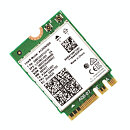Monday, September 7th 2020

AMD to Enter Network Hardware Market, Develop WiFi Controller Products with MediaTek
Intel has a dominating position over the client-segment 802.11ax Wi-Fi 6 NIC controller market. The company's wireless NICs have a near monopoly over WLAN cards inside notebooks, including those powered by AMD processors. Intel further leverages its own brand NICs under the vPro feature-set, providing an end-to-end management solution covering even the NIC. AMD needs to change this, especially if it wants its PRO feature-set to match up to vPro.
AMD is planing to enter the network hardware segment by developing WLAN controllers of its own, which will power future generations of Ryzen processor-powered notebooks, including Ryzen PRO ones; and possible become a staple for desktop PC motherboard vendors on the AMD platform. To cut through the toughest part about coming up with new NICs - the web of IP, AMD has decided to partner with MediaTek, which manufactures mobile SoCs, and cellular MODEM chips, and has the required IP to make standalone WLAN controllers. The first AMD WLAN controllers could build on existing MediaTek IP blocks.
Source:
DigiTimes
AMD is planing to enter the network hardware segment by developing WLAN controllers of its own, which will power future generations of Ryzen processor-powered notebooks, including Ryzen PRO ones; and possible become a staple for desktop PC motherboard vendors on the AMD platform. To cut through the toughest part about coming up with new NICs - the web of IP, AMD has decided to partner with MediaTek, which manufactures mobile SoCs, and cellular MODEM chips, and has the required IP to make standalone WLAN controllers. The first AMD WLAN controllers could build on existing MediaTek IP blocks.

22 Comments on AMD to Enter Network Hardware Market, Develop WiFi Controller Products with MediaTek
Just like Nvidia sells bundled RAM with their GPUs to the OEMs, it makes sense to sell as many parts as possible when it comes to a laptop to the OEMs. Even more so if you can guarantee compatibility. It's also only one place to go for support, instead of having to work with several different companies that will blame each other.
Initially, AMD created clones of Intel products. Intel then started blocking IP (illegally) and AMD had to come up with their own designs. Soon, thereafter, AMD was matching and eventually outperforming Intel's offerings.
cross licencing deals Between AMD and Intel Had the Effect of legally Blocking all those other Chip makers with a x86 Licence from Future Development.
Intel created the first x86 in 1978, and AMD made the technology exchange agreement for the x86 in 1981, which also extended the original 1976 agreement.
The "end-to-end management solution" is the name of the game and was always low priority on AMD's agenda, even after developing their own CPUs 25 years ago. The ATI buyout was supposed to be the solution but instead it was just an expensive GPU IP. Stable chipsets (with RAID) and LAN/WLAN networking are just as important for OEMs.
First AMD licensed VIA chipsets for K6 and K7. Then K8 (Opteron) launched with the first AMD chipset (8000 series) but it was only a "demo" and not developed further. nForce was strong and quickly became the best, and there were lots of other chipsets: VIA, ULi/ALi(nVidia), SiS, and later ATI(AMD) being the worst. Fast forward 10 years and AMD dropped the in-house design and licensed ASMedia chipsets for Zen (X570 with ASMedia IP).
LAN/WLAN IP have Intel, Broadcom, Atheros(Qualcomm), Ralink(Mediatek) and Realtek. I'm surprised AMD didn't license Realtek... but seriously, why not Broadcom or Atheros, their former partners?